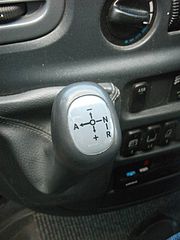Sprint shift

Sprintshift is the brand name for an automated vehicle transmission from Mercedes-Benz , which is mainly used in minibuses and vans of the Mercedes-Benz brand. It combines the operating method and the convenience features of an automatic transmission with the technology and functionality of a manual transmission. Hence it is also called an automated manual transmission .
The basis is a conventional six-speed manual gearbox with a single-plate dry clutch , in which the electronics control all gearshift and clutch processes hydraulically. Two operating modes are available to the driver: in the fully automatic mode, when driving forward, as in an automatic transmission, all gears are automatically shifted depending on the current engine speed, the speed (wheel speeds), the movement of the accelerator pedal and other operating states. However, the driver can manually intervene in the shifting process at any time by moving the shift lever forwards or backwards and shift through the transmission like a manual transmission.
Instead of an H gate, the gearshift lever has a manual and an automatic gate, and there is no clutch pedal . From the starting position (middle position), the shift lever has two tactile and two detent positions. In manual mode, the switching lever for the key positions - / + is moved forwards or backwards by tapping it. The lever returns to its starting position after the switching movement. The gear currently engaged or selected automatic mode (A) is shown on a display in the speedometer instrument. You can switch between the two modes at any time while driving. Moving the lever to the left switches the gearbox to automatic mode, and gears can be selected manually with up and down movements of the lever. Idle and reverse each have a detent position, which means that the shift lever remains in that position.
In manual mode, the control system disconnects the clutch if the engine threatens to stall at too low a speed and automatically shifts to a lower gear. Likewise, the electronics only allow gear changes within a certain speed range, so that over-revving the engine is avoided.
When starting up on inclines, the service brake is only released with a short delay so that rolling back is avoided during normal starting.
In practice, due to a lack of knowledge of the route and the lack of anticipatory driving skills, the electronics naturally shift more frequently than a driver might do in manual shift mode. In front of a hilltop, a driver would stay in a lower gear at a higher engine speed, while the automatic shifts first up and then down again due to the incline. However, due to the more frequent gear changes, the engine moves more frequently in the consumption-optimized ("green") range, which results in lower fuel consumption. Frequent and, above all, rapid load changes often lead to so-called "switching holes" or pendulum switching. The Sprintshift transmission also uses the "kick-down" effect when accelerating rapidly. That is, it briefly shifts to lower gear for a higher torque.
For medium-sized and heavy commercial vehicles, Mercedes-Benz offers various electropneumatic circuits that function in the same way as the sprintshift circuit. Such automated manual transmissions are common today in almost all European trucks, in the passenger car segment they play an outsider role. Classic automatic transmissions are usually installed in the latter, but they also offer manual intervention options.
The Sprintshift transmission was withdrawn from the range in 2012. For the VW Crafter model, which is identical to the Sprinter, Volkswagen Commercial Vehicles offers an identically working circuit called Shiftmatic (SMC) , which, however, will continue to be manufactured by Mercedes-Benz.